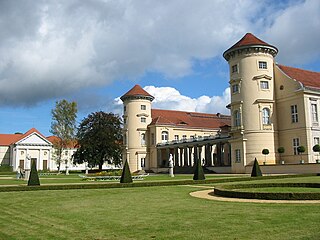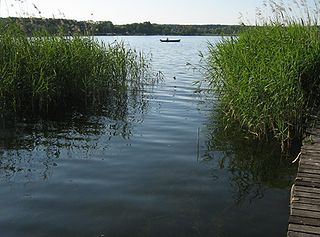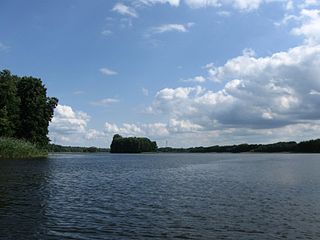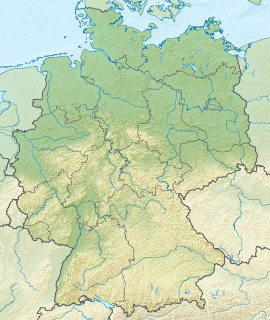
The Havel is a river in north-eastern Germany, flowing through the German states of Mecklenburg-Vorpommern, Brandenburg, Berlin and Saxony-Anhalt. It is a right tributary of the Elbe and 325 kilometres (202 mi) long. However, the direct distance from its source to its mouth is only 94 kilometres (58 mi).

Rheinsberg is a town and a municipality in the Ostprignitz-Ruppin district, in Brandenburg, Germany. It is on the Grienericksee and the river Rhin, approximately 20 km north-east of Neuruppin and 75 km north-west of Berlin.

The Müritz (help·info) is a lake in Mecklenburg-Vorpommern, northern Germany. Its area is 117 km2 (45 sq mi), which makes it the second largest lake in Germany and the largest lake located entirely within German territory.

Zootzensee is a lake in the Rheinsberg Lake Region, Brandenburg, Germany. It has an elevation of 21 metres (69 ft) and a surface area of 1.67 square kilometres (0.64 sq mi). It lies within the municipality of Rheinsberg.

Großer Labussee is a lake in the Mecklenburg Lake District, in Germany. It is situated in the district of Mecklenburgische Seenplatte of the state of Mecklenburg-Vorpommern. Most of the lake is in the municipality Userin, with a small southern part in the municipality Wesenberg.

Woblitzsee is a lake in the Mecklenburg Lake District, in Germany. It is situated in the district of Mecklenburgische Seenplatte of the state of Mecklenburg-Vorpommern. The town of Wesenberg can be found at the south-west end of the lake.

The Großer Zechliner See is a lake in the Rheinsberg Lake Region of Brandenburg, Germany. It is in Rheinsberg, and its surface area is 1.8 square kilometres (0.69 sq mi).

The Tietzowsee is a lake in the Rheinsberg Lake Region in the German state of Brandenburg. It covers and area of 44 hectares within the municipality of Rheinsberg.

Wangnitzsee is a lake in the Mecklenburg Lake District, in the German state of Mecklenburg-Vorpommern. It is situated in the district of Mecklenburgische Seenplatte.

Ellbogensee is a lake in the Mecklenburg Lake District, in Germany. Although most of the lake is in the district of Mecklenburgische Seenplatte in the state of Mecklenburg-Vorpommern, a portion of its southern shore is in the state of Brandenburg. It has a distinctive shape, reflecting its name.

Großer Priepertsee is a lake in the Mecklenburg Lake District, in the German state of Mecklenburg-Vorpommern. It is in the district of Mecklenburgische Seenplatte.

Ziernsee is a lake in the Mecklenburg Lake District, in Germany. Whilst most of the lake is in the district of Mecklenburgische Seenplatte in the state of Mecklenburg-Vorpommern, a portion of its southern shore is in the state of Brandenburg.

Baalensee is a lake in the Mecklenburg Lake District, in Germany. It is situated in the district of Oberhavel in the state of Brandenburg, and lies immediately to the east of the centre of the town of Fürstenberg.

Schwedtsee is a lake in the Mecklenburg Lake District, in Germany. It is situated in the district of Oberhavel in the state of Brandenburg, and lies to the east of the centre of the town of Fürstenberg. The site of the Ravensbrück concentration camp was adjacent to the lake, and a memorial is now situated between the lake and the camp site.

Stolpsee is a lake in the Mecklenburg Lake District, in Germany. It is situated in the district of Oberhavel in the state of Brandenburg. The resort of Himmelpfort lies on the north bank of the lake.

The Breitlingsee, or Breitling See, is a lake in the state of Brandenburg, Germany. It is situated to the west of the city of Brandenburg an der Havel, and is one of a number of directly linked lakes, along with the Möserscher See, Plauer See, Quenzsee and Wendsee.

Wendsee is a lake in the state of Brandenburg, Germany. It is situated to the west of the city of Brandenburg an der Havel, and is one of a number of directly linked lakes, along with the Breitlingsee, Möserscher See, Plauer See and Quenzsee.

The Silo Canal, or Silokanal in German, is a canal in the German state of Brandenburg. It provides a short cut for vessels navigating the River Havel, avoiding the winding and constricted navigation through the city of Brandenburg an der Havel.

The Beetzsee is a lake in the state of Brandenburg, Germany. It is situated to the north and east of the city of Brandenburg an der Havel. It consists of four lake separate lake basins, which are connected by narrow channels. The uppermost of these basins is also known as the Riewendsee.

The Neustrelitz Little Lakes Region is a landscape in the south of the German state of Mecklenburg-Vorpommern, in der region around the town of Neustrelitz, and in the north of the state of Brandenburg, north of Rheinsberg. The northern part of the lakeland region is drained by the River Havel, which also has its source here. There is a link through the Prebelow Canal to the southern part, the Rheinsberg Lakeland, which is drained by the Rhin. There is another link along the Mirow Canal and the Alte Fahrt to the Mecklenburg Great Lakeland. To the east is the Feldberg Lake District.
























